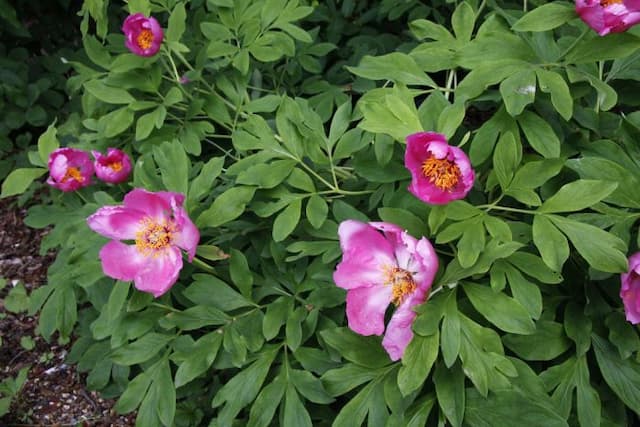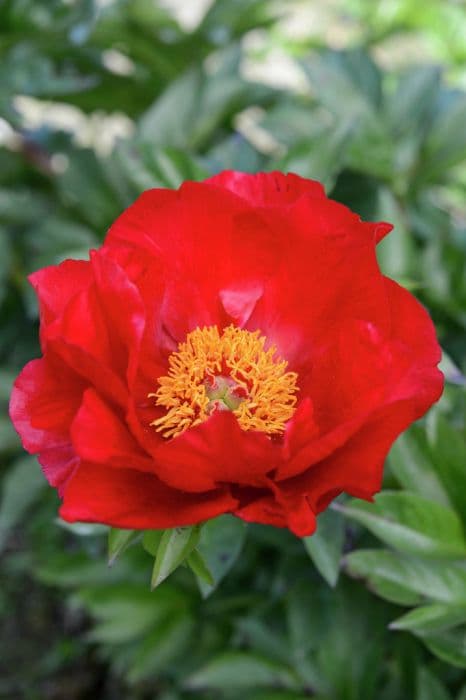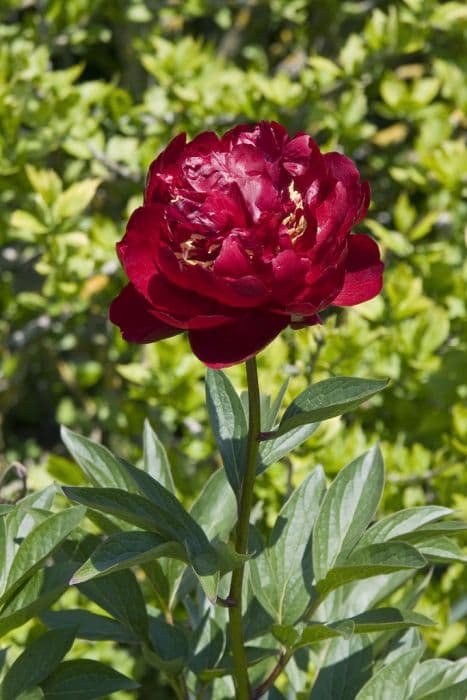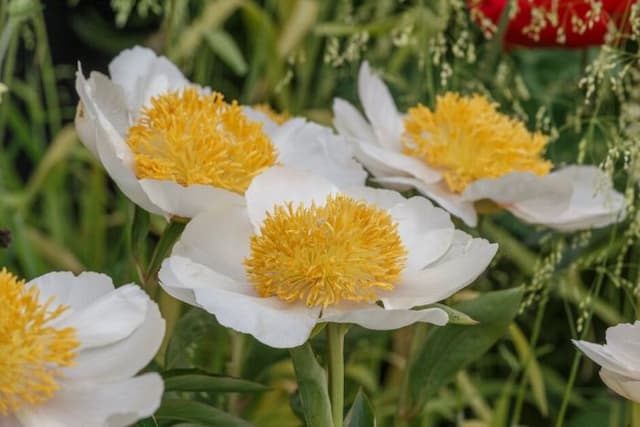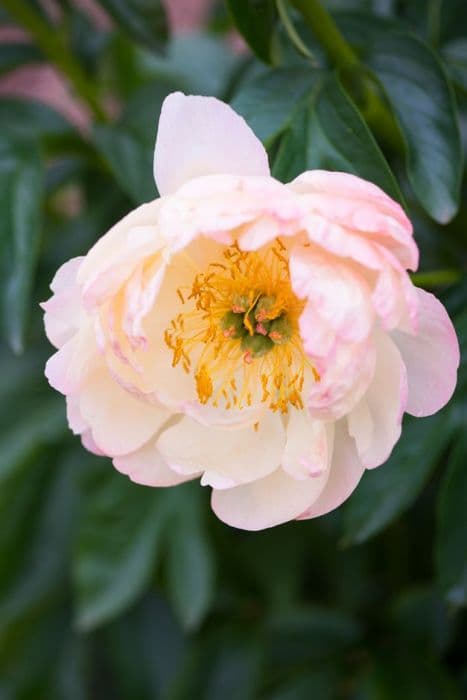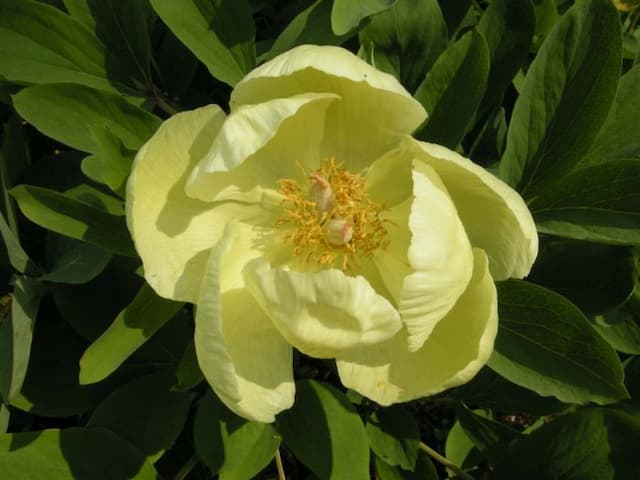Chinese peony Paeonia lactiflora 'Auguste Dessert'

ABOUT
Paeonia lactiflora 'Auguste Dessert' is commonly known as the Chinese peony. This plant boasts large, sumptuous blooms that are a sight to behold. Each flower is composed of several layers of silky petals, which can vary in color from soft pink to a deeper rose hue. The petals may display a silver sheen to their tips, adding an extra touch of sophistication and elegance. At the center of these lavish blossoms, a cluster of golden-yellow stamens forms an attractive contrast, serving as both a visual and pollinator attractant. The flowers exude a delightful fragrance, which is sweet and pleasing to the senses, attracting both humans and pollinators alike. The foliage of 'Auguste Dessert' is equally attractive, with glossy, deep green leaves that have a leathery texture. The leaves are divided into several lobes and provide a lush background that highlights the beauty of the flowers. The plant has an overall bushy and robust habit, contributing to its popularity as a garden specimen. As a Chinese peony, 'Auguste Dessert' embodies the classic charm associated with this group of peonies, known for their long history of cultivation and admiration in gardens. It is a perennial that returns year after year to grace gardens with its magnificent display. With its captivating flowers and pleasant scent, 'Auguste Dessert' is often used as a cut flower, adding a touch of luxury and romance to floral arrangements. Gardeners treasure it for its decorative qualities, making it a coveted addition to mixed borders, flower beds, and as a standalone focal point. It's worth noting that while discussing this plant, its overall dimensions, and growth patterns like spacing and the area covered are omitted as requested.
About this plant
 Names
NamesFamily
Paeoniaceae
Synonyms
Chinese Peony, Common Garden Peony
Common names
Paeonia lactiflora 'Auguste Dessert'.
 Characteristics
CharacteristicsLife cycle
Perennials
Foliage type
Deciduous
Color of leaves
Green
Flower color
Pink
Height
2-3 feet (60-90 cm)
Spread
2-3 feet (60-90 cm)
Plant type
Herb
Hardiness zones
3-8
Native area
Asia
Benefits
 General Benefits
General Benefits- Ornamental Value: The plant features large, fragrant blossoms that are highly decorative and commonly used in landscaping and garden design.
- Cut Flower Use: The blooms make excellent cut flowers, providing beauty and a sweet fragrance indoors.
- Variety of Colors: Paeonia lactiflora 'Auguste Dessert' comes in a range of colors, allowing for diverse garden color schemes.
- Longevity: These peonies are known for their long life span, often living for many years and becoming more prolific over time.
- Seasonal Interest: The plant provides interest in the late spring and early summer, a time when few large-flowered plants are blooming.
- Attracts Pollinators: The flowers attract bees and other pollinators, supporting the local ecosystem.
- Easy to Grow: Peonies are generally easy to care for and can thrive with minimal maintenance once established.
- Drought Resistance: Once established, peonies can be quite drought-tolerant, needing only occasional watering.
- Cold Hardiness: Peonies are suited to cooler climates and can survive harsh winters.
- Deer Resistance: These plants are usually not favored by deer, making them a good option for gardens in areas with high deer populations.
 Medical Properties
Medical Properties- Anti-inflammatory: Paeonia lactiflora 'Auguste Dessert', like other peony varieties, is traditionally used for its anti-inflammatory properties.
- Antispasmodic: It is known to help relieve muscle spasms.
- Anodyne: Peony is sometimes used for its pain-relieving effects.
- Nervine: It is occasionally used in traditional medicine to calm nerves.
- Emmenagogue: Historically, peony has been used to regulate menstrual flow.
 Air-purifying Qualities
Air-purifying QualitiesThis plant is not specifically known for air purifying qualities.
 Other Uses
Other Uses- Culinary decoration: The petals of the peony can be used to add a splash of color to salads and desserts.
- Artistic inspiration: Artists may use the intricate beauty of the peony flowers as a subject for paintings, drawings, and photography.
- Fabric design: The pattern and shape of peony flowers can inspire designs for textiles and wallpaper.
- Natural dye: The petals of the peony can be used to create a natural dye for fabrics or crafting projects.
- Garden companion planting: Peonies can be planted alongside other plants to create aesthetically pleasing garden designs.
- Event decoration: Peony flowers are commonly used in floral arrangements for weddings and other special events.
- Scented sachets: Dried peony petals can be used in sachets to naturally freshen and scent drawers and closets.
- Handmade paper: The petals of peonies can be incorporated into handmade paper to add texture and visual interest.
- Floral crafts: Dried peony blooms can be used in wreaths, potpourri, or other dried floral arrangements.
- Education and research: Horticulture students and botanists may use the peony for studies in plant morphology and breeding.
Interesting Facts
 Feng Shui
Feng ShuiThe Peony is not used in Feng Shui practice.
 Zodiac Sign Compitability
Zodiac Sign CompitabilityThe Peony is not used in astrology practice.
 Plant Symbolism
Plant Symbolism- Beauty: Given its ornate and lush blossoms, this variety of peony symbolizes unmatched beauty and is often associated with the ideal of feminine allure.
- Romance: Peonies are commonly used in wedding bouquets and floral arrangements as they represent love, affection, and happy marriage.
- Prosperity: In many cultures, peonies are believed to bring good fortune and prosperity, making them a popular choice for celebratory occasions.
- Honor: The full and rounded blooms of the peony are associated with honor and high esteem, particularly in societies that value respect such as in Japan and China.
- Riches: With its lush, full petals, this peony is often symbolic of wealth and abundance, hinting at a metaphorical richness in life or spirit.
- Nobility: The peony, due to its regal appearance, is synonymous with nobility and can represent class and distinction.
- Compassion: In some interpretations, the soft and gentle nature of the peony's appearance makes it a symbol for compassion and heartfelt emotion.
- Bashfulness: Stemming from Greek mythology where nymphs were believed to hide in its petals, peonies can indicate shyness or bashfulness.
 Water
WaterPeonies, including the Paeonia lactiflora 'Auguste Dessert', should be watered deeply once a week during their active growth period, especially if the weather is dry. Provide about 1 inch of water to saturate the soil to a depth of 6-8 inches, which equates to roughly half a gallon per square foot. Adjust watering depending on rainfall, reducing it when rain provides moisture. During dormancy in the fall and winter, reduce watering significantly. Over-watering or poor drainage can lead to root rot, so ensure the soil is well-draining.
 Light
LightPeonies like the Paeonia lactiflora 'Auguste Dessert' prefer full sun to partial shade, with at least 6 hours of sunlight each day. They perform best in a spot that receives early morning sun, as this helps dry dew from the leaves and can decrease the likelihood of some fungal diseases. Partial shade is acceptable, especially in the afternoon, to protect the flowers from intense, direct sunlight which may shorten bloom duration; nonetheless, too much shade will reduce flowering.
 Temperature
TemperatureThe common peony, including Paeonia lactiflora 'Auguste Dessert', thrives in USDA hardiness zones 3 through 8, withstanding minimum winter temperatures of -40 degrees Fahrenheit. They enjoy a temperate climate and can survive brief periods of higher temperatures, but sustained heat above 90 degrees Fahrenheit can be detrimental. Peonies flourish in temperatures ranging from 65 to 75 degrees Fahrenheit during their growing season.
 Pruning
PruningPeonies such as the Paeonia lactiflora 'Auguste Dessert' should be pruned to remove spent flowers after blooming to maintain a neat appearance and prevent seed formation, which can divert energy from the plant. In fall, after the foliage has yellowed, cut back the stems to just above ground level to prepare for winter and help prevent overwintering of diseases. Pruning is typically done annually; timing is essential to avoid cutting back early while the leaves are still green, as they feed the tuber for the next season's growth.
 Cleaning
CleaningAs needed
 Soil
SoilFor the best soil mix for Chinese Peony, combine two parts garden soil, one part compost or well-rotted manure, and one part perlite or sand for drainage. Chinese Peony thrives in neutral to slightly alkaline soil with a pH of 6.5 to 7.5.
 Repotting
RepottingChinese Peony rarely needs to be repotted as it prefers to be left undisturbed. It's best to replant or divide these perennials every 10 to 15 years, if necessary, in the fall after the plant has become dormant.
 Humidity & Misting
Humidity & MistingChinese Peony plants are tolerant of most humidity levels; they do well in the average humidity found in outdoor garden settings rather than being concerned with specific indoor humidity conditions.
 Suitable locations
Suitable locationsIndoor
Provide bright light, cool temperatures, and plant in deep pots for Chinese Peony.
Outdoor
Choose a sunny spot, well-draining soil, and space plants for Chinese Peony.
Hardiness zone
Chinese Peony is suitable for 3-8 USDA hardiness zones.
 Life cycle
Life cyclePaeonia lactiflora 'Auguste Dessert', commonly known as Chinese peony, begins its life cycle as a dormant root that typically breaks dormancy in early spring when soil temperatures warm up. The plant then develops several stems that grow upward, unfurling compound leaves and eventually bearing large, showy flowers. After blooming in late spring to early summer, the plant sets seed if pollination occurs, within a seed pod that eventually dries and opens. Throughout the summer, the plant focuses on storing energy in its root system to survive the upcoming dormancy. As autumn approaches, the foliage begins to yellow and die back, and the plant goes dormant for the winter, withdrawing energy into its roots. The life cycle repeats each year, with the plant gradually increasing in size and flower production as it matures.
 Propogation
PropogationPropogation time
Early autumn
Propogation: Paeonia lactiflora 'Auguste Dessert', commonly known as the Chinese peony, is typically propagated through division, which is the most popular method. The best time to propagate this plant by division is in the fall, after the foliage has died back. This allows the plant to establish in cooler temperatures with less stress. To propagate, carefully dig up the peony clump and gently shake off the excess soil. Using a sharp knife or garden spade, divide the clump into smaller sections, ensuring that each section has at least three to five eyes, which are the potential growth points for next year's shoots. After division, replant the sections at the same depth they were previously growing, spacing them about 3 feet (approximately 0.91 meters) apart to allow for mature spread. Water the newly planted divisions thoroughly to settle the soil around the roots and keep them moist until the ground freezes in colder climates.
